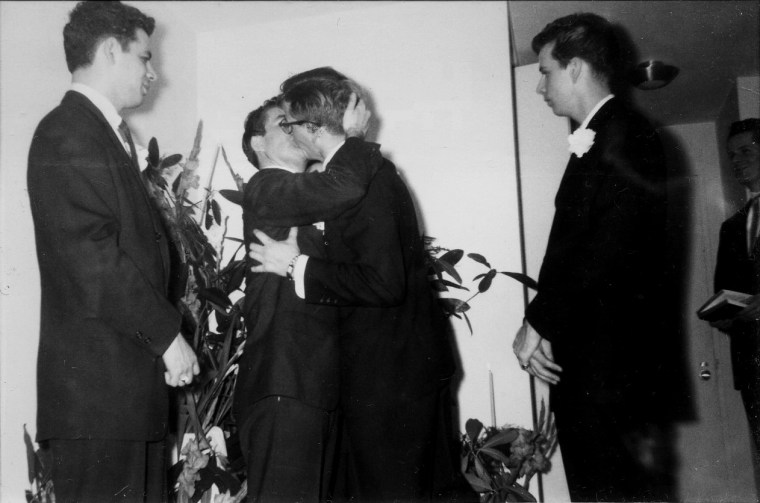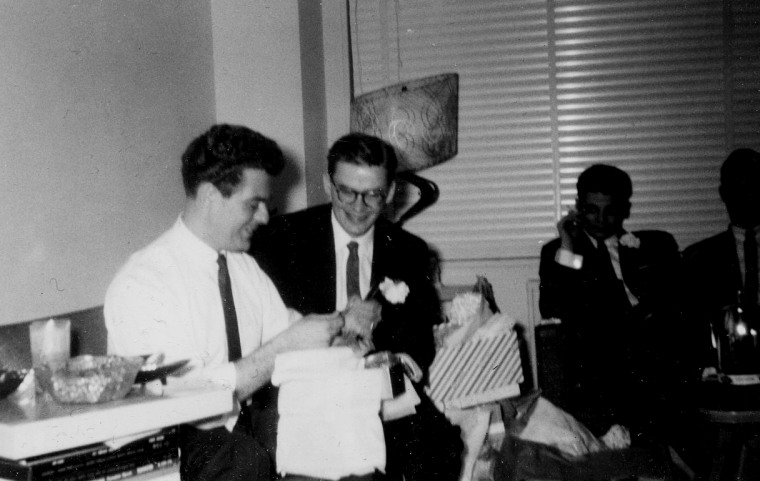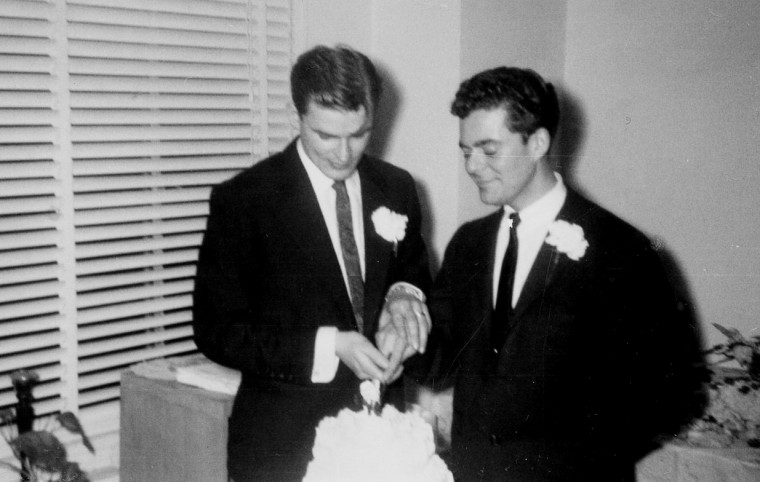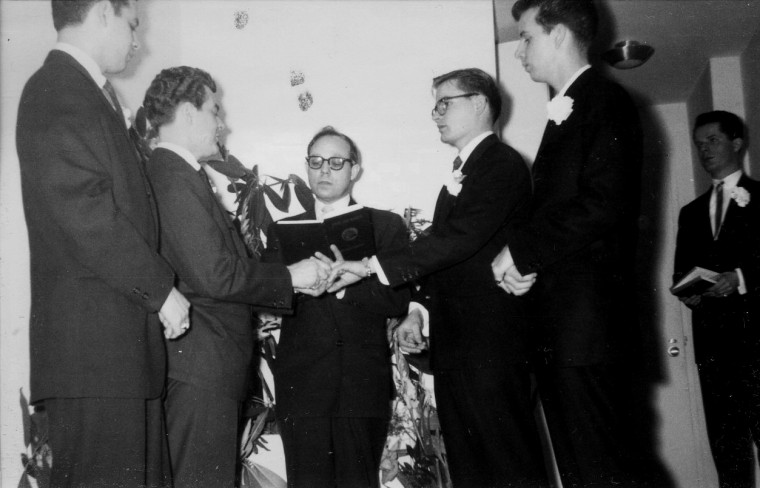Have You Seen These Men? Married in 1957 Not Allowed To Keep their Photos
 |
| The mysterious wedding photos of a gay couple were first printed in 1957 in a drug store in Philadelphia.Courtesy of the John J. Wilcox Archives |
By John Paul Brammer
Two men dressed in their Sunday best, boutonnieres on their lapels, are pictured jointly cutting into a cake. In another photo, they share a passionate kiss as two attendees, perhaps their best men, look on. The year is 1957, over a decade before New York City’s Stonewall riots would reshape LGBTQ history in America as we know it.
Black and white images of this intimate wedding ceremony, held more than half a century ago, recently surfaced online after making their way into the public archives of the ONE Archives Foundation in Los Angeles and the John J. Wilcox Jr. Archives of Philadelphia. The photos have piqued the interest of LGBTQ history buffs and those who want to find the couple, so the men can finally, six decades later, receive their wedding pictures.

The snapshots were unearthed by the daughter of a woman who worked at the Philadelphia drug store where where one of the gay men had tried to get the pictures developed, according to ONE Archives Foundation. The shop’s staff, however, deemed the images “inappropriate” and withheld them from the man.
“My mother had a somewhat photographic memory for faces and retained these in the event the customers who dropped them off ever came back to the shop so that she could give them to the customers on the sly,” the shop worker’s daughter wrote in a letter to the ONE Archives Foundation.
The woman unearthed the photos 60 years later and sold them on eBay in 2013 to a donor who then gave them to the ONE Archive Foundation. The images later made their way to the John J. Wilcox Jr. Archives of Philadelphia and were recently featured on the local news site Philadelphia Citizen. Historians and social media users interested in the story have been searching for the grooms since then to no avail. That quest continues apace, but meanwhile, the photos offer a unique glimpse into the everyday lives of gay people in a time that is too often construed as little more than a waiting period before the social upheavals of the ‘60s.

Marc Robert Stein, a history professor at San Francisco State University and author of the book “City of Sisterly and Brotherly Loves: Lesbian and Gay Philadelphia, 1945-1972,” is uniquely qualified to speak on that past and help paint a fuller picture of the world the men from the photos might have lived in. It is unknown, however, whether the men lived in Philadelphia, or whether the photos were taken there.
Stein notes, importantly, that it was legal for the drug store's photography shop to turn the grooms away all those years ago, and it remains legal for businesses to do so today in much of the U.S.
Stein’s work helps bring into clarity the relationship between the LGBTQ community and commercial establishments in the midcentury, along with the challenges gay people faced from society at large and police in particular.
“We tend to associate beat coffee houses with San Francisco, but many American cities had them, and they were popular with jazz aficionados, poets, interracial couples and LGBTQ people,” Stein told NBC News of the popular gay gathering places at the time. “Many were targeted by police, like Humoresque, which was open right around the time Captain Frank Rizzo was beginning his political rise.”
Rizzo, whose image can be found today in a commemorative statue on Paine Plaza in front of Philadelphia’s Municipal Services Building, had a reputation for cruelty toward LGBTQ people and communities of color. At the time the wedding photos were thought to be taken, Rizzo would have been captain of the Philadelphia police force and regularly conducting raids on establishments that LGBTQ people frequented, using the excuse of drugs and noise complaints to harass patrons.
“It illustrates that on the one hand, there were dozens of commercial establishments including bars and clubs frequented by LGBTQ people, socializing and congregating in solidarity,” Stein said. “On the other hand, they were constantly under threat by police raids, violence, and harassment. Humoresque was the most publicly visible example.”
In early 1959, Rizzo led a raid on Humoresque Coffeeshop that resulted in the arrest of the owner and 34 patrons, presumably many of them gay, according to The Philadelphia Partisan. The police raids on establishments frequented by gay patrons reportedly started in the early ‘50s and continued well into the 1970s.
But even under these conditions, same-sex wedding ceremonies and rituals were taking place, albeit usually undercover and certainly a long way off from being recognized by the city or state in any capacity. One such ceremony is documented in the pages of The Philadelphia Tribune, the oldest continuously published black newspaper in the United States.

On April 14, 1953, the paper had as its front-page story an article about a police raid on a wedding between two black women in their North Philadelphia home. The younger woman was described as “a blushing bride,” Stein said, while the older woman “was dressed in male clothes and went by the nickname ‘Duke.’” The article described a five-tiered wedding cake, a 10-pound turkey and “an unusual amount” of alcoholic beverages.
Duke, it is reported, argued with authorities that the wedding was merely entertainment for guests and that such a ceremony between two women was clearly a ruse, an elaborate ploy to throw a “pay and eat” party. This was strategic on Duke’s end, Stein said because it challenged her audience to be smart and offered Duke the option to play dumb. This was what survival for LGBTQ people often looked like back then: cleverly skirting law enforcement with a wink and a nod that others in the community would recognize.
The men in these recently unearthed wedding photos, if they are still alive, are likely in their late 80s or early 90s. There is presently nothing else known about them or their wedding guests, but regardless, their images shine additional light on a community that was often forced to hide in the shadows.
“It’s important for LGBTQ people to see ourselves represented in the past,” Stein said. “There’s this myth that life before the Stonewall riots was completely dark and dreary, and to see celebratory images of happy gay people fascinates us.”
Editor’s note: If you know the grooms — or if you're one of them — please contact nbcout@nbcuni.com.
Comments